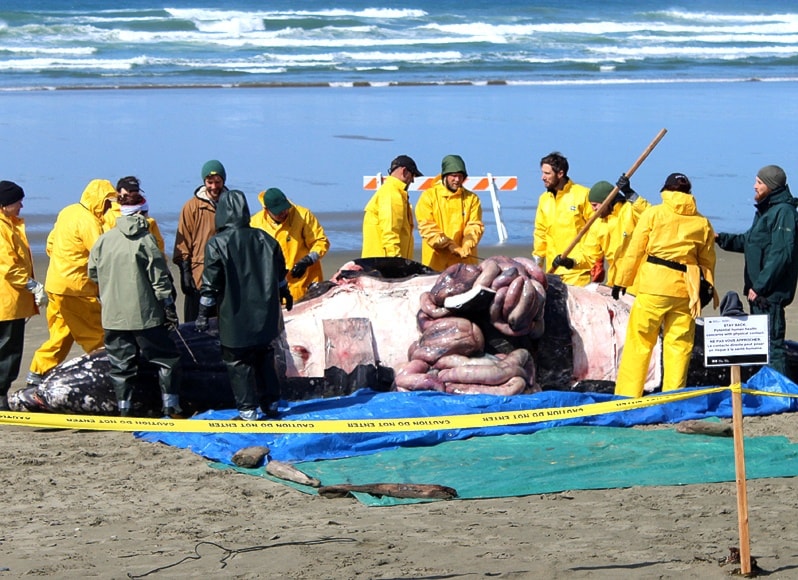A dead gray whale found washed up on Wickaninnish Beach Monday morning was being diced up at the beach Thursday afternoon.
Lisa Spaven of the Department of Fisheries and Oceans Canada’s (DFO) cetacean research program supervised the necropsy and disarticulation of the sub-adult gray whale.
She told the Westerly the whale was a roughly 10-metre-long, one-year-old, female.
“Within the Pacific Rim National Park, most of what washes up is small and portable and we can take it back to the lab whole. Obviously with a gray whale of this size, it’s got to be dealt with on the beach,†Spaven said.
“The necropsy is being done as a collaboration between Parks Canada, Fisheries and Oceans Canada, Royal BC Museum, Vancouver Aquarium, Ucluelet Aquarium and a whole bunch of other local experts that we were able to wrangle together.â€
The Park’s human wildlife conflict specialist Todd Windle was stoked to see about 10 local volunteers brave Thursday morning's rain and show up to assist.
“It was a pretty classic West Coast morning and to see everybody out here and jumping into a bit of a smelly, mucky, job on a wet morning; it’s really great to see all these volunteers out here helping us,†he said.
Windle said a necropsy was not initially planned when the whale washed ashore, but after consultations with DFO it was determined the carcass would need to be chopped up anyway to be removed from the beach.
“We can’t leave a whale carcass to decompose in a high use area like this, it’s obviously going to be a wildlife attractant, so it did need to get moved and (DFO) just wanted to take advantage of that opportunity,†Windle said.
Spaven said gray whales are listed as a species of special concern under the species at risk act.
“The scientific need to determine cause of death isn’t as high as with threatened and endangered animals,†she said.
“If the easiest way to get rid of it was to take it to sea then we would not have been doing a necropsy, that option didn’t work...and we also found someone to take possession of the bones for archive and display purposes. So for that reason we’re now opening up the animal and I’ll take the samples I need.â€
She said the necropsy won’t necessarily determine a cause of death.
“Certainly any opportunity we get, within reason, to try and determine cause of death helps to figure out what we can do to mitigate the threats to the species,†she said.
“We don’t know the cause of death. There aren’t any external signs that would lead us in any one direction at this point and, by the looks of things so far, we may not be able to come to any kind of educated guess by the necropsy alone.â€
She said samples and photographs of the whale would be sent to the Animal Health Centre in Abbotsford for further analysis.
The whale’s skeleton will be going to the Royal BC Museum in Victoria for educational display purposes, according to Spaven.
reporter@westerlynews.ca
